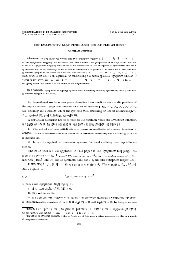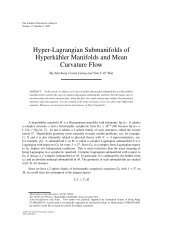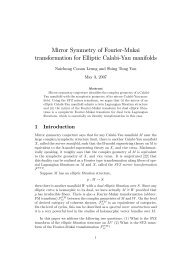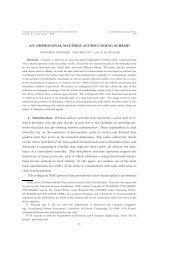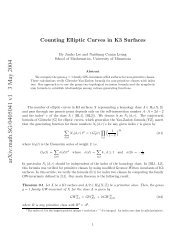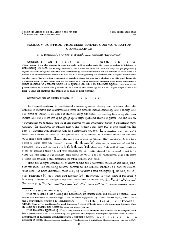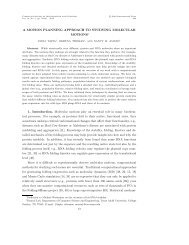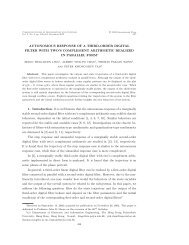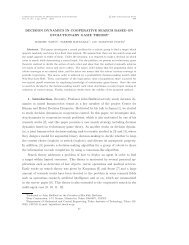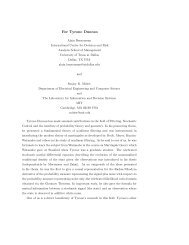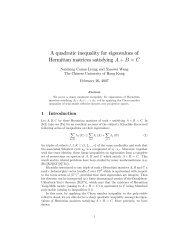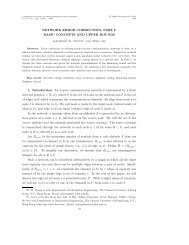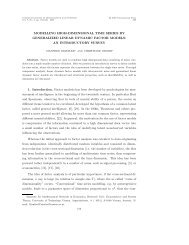AN OPTIMAL DISTRIBUTED ROUTING ALGORITHM USING DUAL ...
AN OPTIMAL DISTRIBUTED ROUTING ALGORITHM USING DUAL ...
AN OPTIMAL DISTRIBUTED ROUTING ALGORITHM USING DUAL ...
You also want an ePaper? Increase the reach of your titles
YUMPU automatically turns print PDFs into web optimized ePapers that Google loves.
286 PUNYASLOK PURKAYASTHA <strong>AN</strong>D JOHN S. BARAS<br />
where for each (i, j),<br />
(18) F ij (p n i − pn j ) = 0, if pn i − pn j ≤ 0,<br />
(19)<br />
F ij (p n i − p n j ) > 0, if p n i − p n j > 0,<br />
and can be determined by solving the equation F ij [D ij (F ij )] β = p n i −pn j . The relations<br />
(17), (18), and (19), can be used as a basis for a distributed algorithm that converges<br />
to a solution of the dual optimization problem. We now describe a general, online<br />
version of such an algorithm. The algorithm can be initialized with an arbitrary<br />
price vector p 0 . (Each node can choose a real number as the initial value of its price<br />
variable.) Let’s suppose that at the start of a typical iteration, the dual vector is p,<br />
with each node i having available information of its own price p i as well as the prices<br />
p j of its neighbor nodes j such that (i, j) ∈ L. Each node i makes an estimate of<br />
the average queueing delay on each of its outgoing links (i, j). This estimate can be<br />
made by taking measurements of the packet delays over a time window and taking<br />
an average, or by using a ‘running’ estimator like an exponential averaging estimator.<br />
The flows F ij (p i − p j ) are then determined by using relations (18) and (19), and<br />
node i adjusts the flows on its outgoing links to these values. Each node i then<br />
broadcasts the updated flow values to its neighbors j. In this way, every node i has<br />
information regarding the flows F ij (p i − p j ) and F ji (p j − p i ) on the links (i, j) and<br />
(j, i), respectively. Node i can then use (17) to update its own dual variable p i , and<br />
broadcasts to all the neighbor nodes this updated value. A fresh iteration can now<br />
commence with these updated dual variables. The general algorithm, as described, is<br />
adaptive and the updates of the dual variables and the flow variables in general take<br />
place asynchronously. As in [26], the outgoing flow on a link depends on the inverse<br />
of the estimated queueing delay on that link.<br />
Although we have described a general, asynchronous, distributed algorithm for<br />
the dual problem, we shall discuss convergence only for the special case of the synchronous<br />
version as given by equations (17), (18), and (19), with ‘perfect’ (‘noiseless’)<br />
measurements of the delays. We can view the gradient algorithm (15) as a special<br />
case of a subgradient algorithm, and employ the results of convergence analysis (see,<br />
for example, Shor [28]) for the latter algorithm. For simplicity, we confine ourselves<br />
to a discussion of the constant step-size case - α n = α, for some small, positive α.<br />
The central result is that, if the gradient vector ∇Q(p) has a bounded norm (that is,<br />
||∇Q(p)|| ≤ G, for some constant G, and for all p), then for a small positive number<br />
h,<br />
(20) Q(p ∗ ) − lim<br />
n→∞ Qn < h,<br />
where Q n is the ‘best’ value found till the n-th iteration, i.e., Q n = max(Q(p 0 ), Q(p 1 ),<br />
. . . , Q(p n )). The number h is a function of the step-size α, and decreases with it. In




